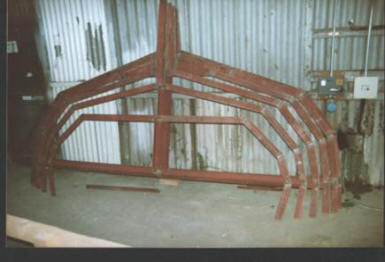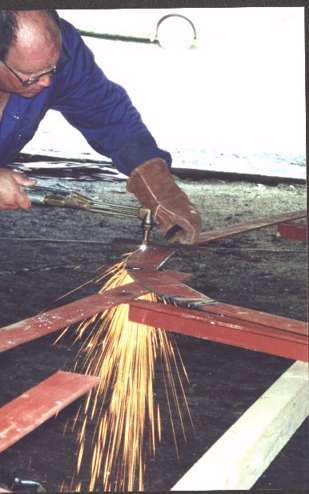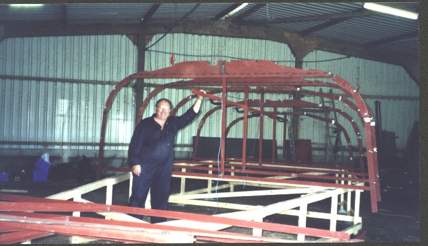Links
Fay Marine Photographs 2

A set of Spray frames waiting for final preparation. This will include cleaning and priming the welds. Cutting the chine bar and stringer notches. Also cutting drain holes and piping holes.
I always build upside down now as having tried it both ways, I have found that the advantages enormously outweigh the disadvantages.
When building upright, trying to lift plates and wedge or clamp them in position, especially when short handed as many home builders will be, is really difficult. However if the hull is being built upside down then gravity is working for you. The plates naturally sit against the frames.
At one time I built two 33ft yachts, upside down, on my own with only occasional help to lift the heaviest plates into position. This would have been almost impossible if building the right way up.

Cutting notches in frames. I prefer to mark with platers chalk where the notch should be and then drill an accurate hole in the frame to cut from. It is usual to cut the top of the notch as a drain hole, but if the insulation is to be sprayed foam this becomes irrelevant.
I have tried all the methods of cutting and always return to oxygen and acetylene. Nibblers are noisy, expensive, slow and have difficulty with thicker plate. Plasma is clean but on all the models I tried the cutting head is large and blocks visibility of what is being cut and is difficult to use inside the hull. Cutting disks in an angle grinder should only be used for cutting stainless and deck beam notches. There are now some 0.8mm thick disks for 4 1/2" grinders that go through stainless like a hot knife through butter, but like all disks are difficult to use on curves.
I use an A.S.M.N. (acetylene sheet metal nozzle) for nearly all cutting. These nozzles are only designed for up to 1/8" (3mm) sheet but I found that an old much cleaned one will cut much thicker plate, with the oxygen pressure turned up a little. This led me to drill out a test nozzle using a pin drill. I have found that I can fairly successfully cut 3/4" (18mm) plate with it. However this is not what these nozzles are designed for so I take no responsibility for your experiments and would also point out that I have nearly 40 years of experience of cutting steel.
Another advantage of gas cutting is that extra long hoses can be purchased, just over half the length of the hull being built. If the bottles are stored roughly amidships then the cutter will reach all over the hull without moving the heavy bottles.

The frames being set up. The headstock can clearly be seen, sitting on the temporary timber building frame. A piece of angle is clamped to the centre line uprights to hold them all in position.
At this point take great care!! The frames could all fall like a pack of cards and although individually they do not weigh a great deal, when massed together they can represent enough weight to do a great deal of damage if they fell. So make sure the temporary supports are strong enough.
Once all the frames are upright the process of lining everything correctly can begin. The headstocks will all be on the same horizontal plane, so can be lined up by eye or better by using a tightly stretched string line. The centre line verticals can also be lined up in the same way. Then using a spirit level on the forward edge of the uprights will set them up correctly.
ŠPaul Fay 2004